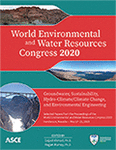World Environmental and Water Resources Congress 2020
Estimation of Atmospheric Carbon Mitigation through Urban Landscaping in Arid Areas Using Native Species
Publication: World Environmental and Water Resources Congress 2020: Groundwater, Sustainability, Hydro-Climate/Climate Change, and Environmental Engineering
ABSTRACT
Carbon capturing and sequestration are of great interest to reduce the carbon dioxide CO2 emissions from the atmosphere. To achieve this, forests, grasslands, and vegetation areas, in general, should be planted and conserved. However, for cultivating a landscape, water resources become an issue for some regions specifically in the arid areas where they have water scarcity and use desalination of seawater for life amenities. Even with using relatively clean energy source (natural gas), desalination is responsible for 12 kg of CO2 eq m-3 with high consumption of electricity and energy resources. Alternating this with treated wastewater with good purity can help reuse of treated sewage effluent TSE, abate the consumption of resources, and mitigate the emissions of CO2. This scenario was applied in the middle east region, particularly in Qatar where the 2022 World Cup event will be held. An intensive project was established near Doha north TSE with the potential of reducing the massive amount of CO2 by natural sequestration through planting trees and grasslands. Efficiently, TSE exclusively was used to cover the need of the whole landscape. In this study, the focus was on studying the potential mitigation of carbon by measuring the operational carbon footprint from facilitating and planting the landscape, the carbon captured by the whole landscape (trees, grassland, soil, etc.), and the net carbon storage and neutralization. Initial results showed that the usage of TSE was able to reduce the CO2 by approximately 12 times compared to desalinated water. With further investigation, the value of carbon sequestration through the landscape can provide positive net carbon storage helping in neutralizing carbon emissions with sustainable and natural facilities.
Get full access to this article
View all available purchase options and get full access to this chapter.
ACKNOWLEDGEMENTS
This research was supported by a scholarship from Hamad Bin Khalifa University (HBKU), a member of the Qatar Foundation (QF). Any opinions, findings, conclusions, or recommendations expressed in this article are those of the author(s) and do not necessarily reflect the views of HBKU or the QF.
REFERENCES
Alhaj, M., Mohammed, S., Darwish, M., Hassan, A., & Al-Ghamdi, S. G. (2017). A review of Qatar’s water resources, consumption and virtual water trade. Desalination and Water Treatment, 90, 70–85. https://doi.org/10.5004/dwt.2017.21246
Arzai, A., & Aliyu, B. (2010). The relationship between canopy width, height and trunk size in some tree species growing in the Savana zone of Nigeria. Bayero Journal of Pure and Applied Sciences, 3(1), 260–263. https://doi.org/10.4314/bajopas.v3i1.58808
Baral, A., & Guha, G. S. (2004). Trees for carbon sequestration or fossil fuel substitution: The issue of cost vs. carbon benefit. Biomass and Bioenergy, 27(1), 41–55. https://doi.org/10.1016/j.biombioe.2003.11.004
Brack, C. L. (2002). Pollution mitigation and carbon sequestration by an urban forest. Environmental Pollution, 116(SUPPL. 1). https://doi.org/10.1016/S0269-7491(01)00251-2
CCSA and TUC. (2014). The economic benefits of carbon capture and storage in the UK.
Clark, A., Saucier, J. R., & McNab, W. H. (1986). Total-tree weight, stem weight, and volume tables for hardwood species in the Southeast. Retrieved December 9, 2019, from https://www.frames.gov/catalog/7537
Department for Business, E. & I. S. (2017). Government emission conversion factors for greenhouse gas company reporting - GOV. UK. Retrieved December 6, 2019, from Greenhouse gas emissions and Energy and climate change: evidence and analysis website: https://www.gov.uk/government/collections/government-conversion-factors-for-company-reporting#conversion-factors-2017%0Ahttps://www.gov.uk/government/collections/government-conversion-factors-for-company-reporting
Environment Agency. (2012). Greenhouse Gas Inventory for Abu Dhabi Emirate. Retrieved from http://www.ead.ae/wp-content/uploads/2014/03/AD-Greenhouse-gas-inventory-Eng.pdf
Marland, G., & Schlamadinger, B. (1997). Forests for carbon sequestration or fossil fuel substitution? A sensitivity analysis. https://doi.org/10.1016/S0961-9534(97)00027-5
Masera, O. R., Garza-Caligaris, J. F., Kanninen, M., Karjalainen, T., Liski, J., Nabuurs, G. J., … Mohren, G. M. J. (2003). Modeling carbon sequestration in afforestation, agroforestry and forest management projects: The CO2FIX V.2 approach. Ecological Modelling, 164(2–3), 177–199. https://doi.org/10.1016/S0304-3800(02)00419-2
Mohammed, S. S. (2016). Qatar’s National Emission Inventory Report. Retrieved December 5, 2019, from https://figshare.com/articles/QATAR_S_NATIONAL_EMISSION_INVENTORY_REPORT/4161213/2
Mynick, H. E., & Williams, R. H. (1991). Alternative Roles For Biomass In Coping With Greenhouse Warming. Science & Global Security, 2(2–3), 113–151. https://doi.org/10.1080/08929889108426356
Nowak, D. J., Walton, J. T., Stevens, J. C., Crane, D. E., & Hoehn, R. E. (2008). Effect of plot and sample size on timing and precision of urban forest assessments. Arboriculture and Urban Forestry, 34(6), 386–390.
Plappally, A. K., & Lienhard, V. J. H. (2012, September). Energy requirements for water production, treatment, end use, reclamation, and disposal. Renewable and Sustainable Energy Reviews, Vol. 16, pp. 4818–4848. https://doi.org/10.1016/j.rser.2012.05.022
State of Qatar Ministry of Development Planning and Statistics. (2014). Environment Statistics Annual Report 2013. Retrieved from www.mdps.gov.qa
Tang, C., Fu, X., Jiang, D., Fu, J., Zhang, X., & Zhou, S. (2014). Simulating Spatiotemporal Dynamics of Sichuan Grassland Net Primary Productivity Using the CASA Model and in Situ Observations. Scientific World Journal, 2014. https://doi.org/10.1155/2014/956963
Information & Authors
Information
Published In
World Environmental and Water Resources Congress 2020: Groundwater, Sustainability, Hydro-Climate/Climate Change, and Environmental Engineering
Pages: 280 - 289
Editors: Sajjad Ahmad, Ph.D., and Regan Murray, Ph.D.
ISBN (Online): 978-0-7844-8296-4
Copyright
© 2020 American Society of Civil Engineers.
History
Published online: May 14, 2020
Published in print: May 14, 2020
Authors
Metrics & Citations
Metrics
Citations
Download citation
If you have the appropriate software installed, you can download article citation data to the citation manager of your choice. Simply select your manager software from the list below and click Download.
